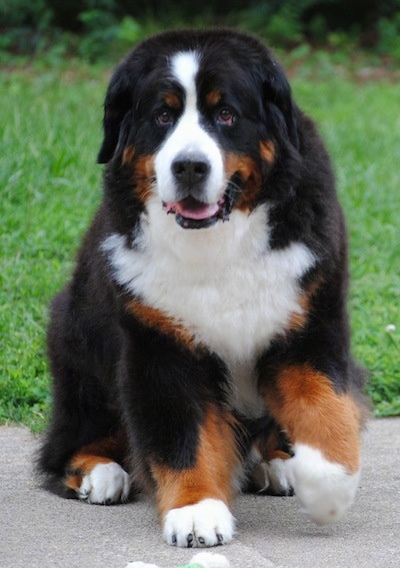Bernese Mountain Dog
- Group 2: Pinscher and Schnauzer - Molossian breeds - Swiss Mountain and Cattle Dogs
- Section 3 Swiss Mountain and Cattle Dogs
- Without working trial
Switzerland
Dürrbächler; Bouvier bernois; Bernese Mountain Dog; Perro de montana boyero Bernes
Male: 64-70 cm Female: 58-66 cm
Not set
The Bernese Mountain Dog, veraltend Dürrbächler, is one of the FCI (FCI Group 2, Section 3, Standard No. 45) of celebrated Swiss breed of dog that belongs to the breed type of mountain dogs.
Description
The Bernese mountain dog is a powerful dog, which reaches up to 70 cm shoulder height. The fur is long and soft, it should be wavy plain (smooth) or slightly. Even the not very large high-set hanging ears are hairy. The main accent of the tri-colored dog is the black coat over body, neck, head and tail. At the end starts a white symmetrical blaze that widens towards the muzzle, but should extend only up to the corner of the lips. A white pectoral cross and white paws are additional features. Often a white tail tip occurs. Brown Red spots above the eyes gave him the old name " Vieräugler ". Brown-red cheeks and just such badge on the side of white chest hair and legs complete the picture. The more symmetrical the three colors are distributed, the more harmonious the image. Front and hind limbs should be well angulated. The movement should be "free and ground covering ."
Use
Bernese Mountain Dogs are not very suitable for dog sports that demand them great maneuverability and speed, such as agility. You'll probably choose the Zughundearbeit, a rescue dog or track search dog training, as well as areas of application in which a kind of pre unsuspecting obedience is required. They need plenty of freedom of movement. Hot weather makes them because of their long and dense coat dress to create. In the winter and cool or freezing temperatures they feel comfortable.
Sanitary
Bernese Mountain Dogs should not be kept as floor dogs ( without lift), since with them, as with other large breeds also, joint problems ( hip, elbow dysplasia ) may occur. They also have an increased susceptibility to kidney disease and cancer (particularly Malignant histiocytosis and mast cell tumors) as well as the meningitis arteritis. The mortality of the race, according to a recent study, twice as high as it would be expected population size; malignant tumors are from the age of four years, a significant cause of death. 17 percent of all Bernese Mountain Dogs die before the age of five years, 45 percent before the age of 8 years, and 72 percent are not 10 years old. As well as the above mentioned diseases degenerative myelopathy is one of the hereditary diseases of the Bernese Mountain Dog. Since this is an autosomal recessive, can be prevented by a DNA test that loaded dogs are bred together. Since 2011 also a genetic test for a newly identified mutation in the SOD1 gene is known.
On behalf of the Swiss Mountain Dog Club of Germany (SSV ) the life expectancy of the Bernese Mountain dog has been scientifically studied. According to these studies, the current average life expectancy is 7 years and 6 months.
The recognized the VDH breed breed clubs use breeding strategies to combat genetic diseases. Transparency over several generations with respect to hip dysplasia, elbow dysplasia, age structure and behavior are a prerequisite. When breeding, the breeder of the SSV the genetic value of use. It is grown as regards durability. The SSV has 2009 phenotypic breeding value life introduced, since 2012 there is also a genomic breeding value for longevity.
The SSV has 2013 introduced a genomic breeding value ( pre-test ) for the histiocytic sarcoma ( malignant histiocytosis ). This test describes the risk for this disease. The breeding values for longevity are correlated with the genomic breeding values for the histiocytic sarcoma, but not identical. This means that dogs with high genomic breeding values for longevity have a lower risk of histiocytic sarcoma and vice versa dogs with a very low risk of histiocytic sarcoma have a higher life expectancy. Since there are other hereditary causes of death in Bernese Mountain dogs next to the histiocytic sarcoma and also some dogs with histiocytic sarcoma - probably by a pronounced immune defense - are old, the further breeding value for longevity will continue to be used.
Nature
Bernese Mountain Dogs are self-confident, kind and friendly. You have a strong guard instinct, without being aggressive. Today they are not only good house and farm dogs, but also popular family pets.
Related breeds
In addition to the Bernese Mountain Dog, there are other three breeds, which are among the Swiss Mountain Dogs: The Greater Swiss Mountain Dog, the Appenzeller Sennenhund and the Entlebucher Mountain Dog. Of the four Sennenhund breeds especially the Bernese Mountain Dog is growing in popularity.








